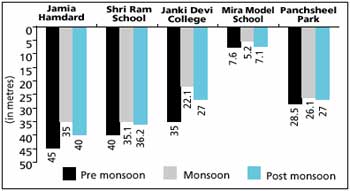| |
A NEW BEGINNING |
|
| A rich
harvest |
||
IN FOCUS |
||
| On the
right track? Groundwater or poison? Punjab, ready for desi solutions Saga of tanks |
||
CAMPAIGN |
||
| Ways to
destroy Squatters or owners? VIPs strangling Dal Restoring Bis Hazari Lakes in News |
||
WATER LITERACY |
||
| For
water security The facilitator Let us try this out? Water carnival |
||
INITIATIVE |
||
| Sabdoo,
surging ahead Pioneering work Reasserting rights Haryana documents Mission possible |
||
JAL BIRADARI |
||
| Common
sense, makes sense Unflinching faith |
||
| NEWS FROM GUJARAT | ||
| Jal
bachao yatra Checking salt ingress Water accounting |
||
NEWS FROM CHENNAI |
||
| Legally
armed Cultivating temple tanks Syndicate residency’s endeavour Optimising benefits |
||
JAL YODHAS |
||
| P K
Senapati Surinder Bansal Shree Padree Anil Rana M N Mitra |
||
TECHNOLOGY |
||
| Fog
collectors Techno tit bits |
||
NEWS FROM ABROAD |
||
| South Africa: Water apartheid Kenya: Drought busting Japan: Water wizards Turks & Caicos Islands: A unique system Nepal: Spouts return |
||

Vol. 4
No.
6 December 2002-
January 2003
![]()
CSE monitors model projects: Startling results
 |
Improving water tables at Model Projects |
Its time to take stock of the performance of the model projects inaugurated in Delhi by CSE in August 2002. What has the impact of rainwater harvesting (RWH) been on the quantity and quality of the groundwater before and after monsoon? Results based on regular monitoring and independent analysis clearly indicates a spectacular improvement. (See graph and table)
22 water samples from 11 different sites were collected and tested for physicochemical flutuations at CSE’s Pollution Monitoring Lab. The sites including Jamia Hamdard University, Janki Devi Memorial College, Mira Model School, The Shri Ram School and Panchsheel Club, School and Colony. These are the five model projects designed by CSE to reaffirm the potential of urban RWH.
A substantial increase in the groundwater levels clearly reinstates the capacity of RWH in plugging the current gap of more than 310 MGD between water demand and supply. Significantly, in 91 per cent of the samples there is a fall in the level of dissolved solids. There is also a decline in the acidity, nitrate, nitrite, chromium and flouride contents.
Rainwater is one of the purest sources of water available.So, if the water table rises after monsoon due to RWH, the quality too improves with the dilution of freshwater.
For details:Eklavya at eklavya@cseindia.org
Srinivasan at rksri@cseindia.org;
Tel: 26081110 / 24 Ext 219
The water quality index
| Indicator | Jamia Ham- dard |
Shri Ram School | Janki Devi | Mira Model | Panch-sheel | |||||
| Pre–M | Post–M | Pre–M | Post–M | Pre– M |
Post– M |
Pre– M |
Post– M |
Pre– M |
Post– M |
|
| pH | 7.11 | 7.45 | 7.26 | 7.73 | 6.32 | 7.19 | 7.26 | 7.73 | 6.59 | 7.39 |
| Nitrate ( Mg / l) |
4.49 | 2.35 | 3.53 | 2.43 | 20.6 | 3.91 | 3.53 | 2.43 | 59.5 | 3.26 |
| Turbidity (NTU) |
2.1 | 1.2 | 3.83 | 2.62 | 2.83 | 0.66 | – | – | 14.98 | 0.36 |
| Acidity ( Mg / l) |
18 | 0 | 20 | 0 | 34 | 0 | 20 | 0 | 50 | 0 |
| Calcium ( Mg / l) |
64 | 21.64 | – | – | 52 | 32 | 40 | 32 | 268 | 48 |
| Magnesium ( Mg / l) |
88 | 32 | – | – | 174 | 50 | 346 | 159.9 | 90 | 71.9 |
| TDS (ppm) | 595 | 517 | 724 | 692 | – | – | – | – | 2140 | 1550 |
| Hardness ( Mg / l) |
160 | 54 | – | – | – | – | 864 | 100 | 218 | 120 |
| Oil & grease (ppb) | 30 | 20 | 40 | 15 | 20 | 10 | 40 | 15 | 30 | 17 |
| Chloride ( Mg / l) |
– | – | – | – | 131 | 75.8 | – | – | 456 | 417 |
| Chromium (Mg / l) | 0.0175 | – | 0.003 | 0 | 0.01 | 0 | 0.003 | 0 | – | – |
| Iron( Mg / l) | – | – | 0.082 | 0 | – | – | 0.082 | 0 | – | – |
| Note: Pre – M = Pre Monsoon; Post – M = Post Monsoon; | ||||||||||